With Decentralized Identity flows, we often use the phrase “proof of control” or “proving control over a credential/identifier”. This post provides a visual description of what that means.
A slightly more formal treatment in DIF Presentation Exchange spec (subject/holder binding > proof of identifier control).
At a high level, it works this way:
- A Verifiable Credential (VC) is issued to a subject (e.g., person), and the subject is identified in the VC by an “identifier” (with the property name
id). - The identifier data type is a URI, which is like a web site URL, but can more general. It can be a Decentralized Identifier (DID) in fact
- If that identifier is backed by cryptographic key material (as with DIDs), then you can use standard crpytographic signatures to sign a message proving you control that identifier.
- At verification time, the credential “holder” can use this property to prove they are the same entity as the credential “subject”. They can do this by wrapping a VC in a Verifiable Presentation (VP) and signing the VP with the corresponding private key material.
And this is how a holder proves they are the subject, by demonstrating control of this shared identifier.
Example
Suppose a VC is issued to a subject with the identifier did:example:1234. It would look like this
{
"@context": [
"https://www.w3.org/2018/credentials/v1",
"https://www.w3.org/2018/credentials/examples/v1"
],
"id": "http://example.edu/credentials/3732",
"type": ["VerifiableCredential", "UniversityDegreeCredential"],
"issuer": "https://example.edu/issuers/565049",
"issuanceDate": "2010-01-01T00:00:00Z",
"credentialSubject": {
"id": "did:example:1234",
"degree": {
"type": "BachelorDegree",
"name": "Bachelor of Science and Arts"
}
}
}
At issuance time….
Before issuing that credential, the issuer would have authenticated the subject in their usual means, and asked the subject to provide a DID that their wallet generated. In this case, the subject’s wallet generated did:example:1234. The issuer could also asked for proof of control along with the DID at this time (this can be done with an empty VP, with DID auth, etc).
The issuer generates the VC, issued to credentialSubject.id = did:example:1234, and sends it back to the subject to store in their wallet. Let’s call it VC(*)

At Exchange / Verification Time

Later, a relying party could ask credential holders to prove they are the credential subject.
The subject retrieves the VC they want to share, VC*, generates a VP, and signs the VP with the private key corresponding to did:example:1234 (or the private key corresponding to a specific public key authorized by did:example:1234). The relying party should also include a “challenge” to prevent replays (i.e., this requires the holder to generate a fresh signature).
This allows the relying party to trust that the original VC hasn’t been tampered with and the subject of the credential is really the intended recipient (possibly with additional levels of identity assurance, as required by the relying party).
## About the wallet and its dependencies
There are 3 objects shown near the subject/holder, called “wallet”, “identifier vault”, and “credential storage.” What are these?
First, individuals aren’t necessarily expected to know about or interact with these as separate entities. I’m using “wallet” as shorthand for the application or entrypoint that individuals use to interact with their identity data. It might be a mobile app, browser plugin, etc.
There’s no point in being overly opinionated on the wallet architecture and its capabilities, which is why “identifer vault” and “credential storage” are called out as possibly separate entities. Some wallets may implement all of these functions, and some may delegate these functions to other processes or services on or off device.
- “identifier vault”: manages decentralized identifiers for an individual, including creation, retrieval, etc. Here I’ve used them as blackboxes that would perform cryptographic signing, in the interest of minimizing exposre of private keys
- “credential storage”: manages (store, retrieve, etc) credentials
More Details
This post focused on holder and subject binding through proof of identifer control. Read this section of the DIF Presentation Exchange spec for information about other methods of holder and subject binding, including biometrics
